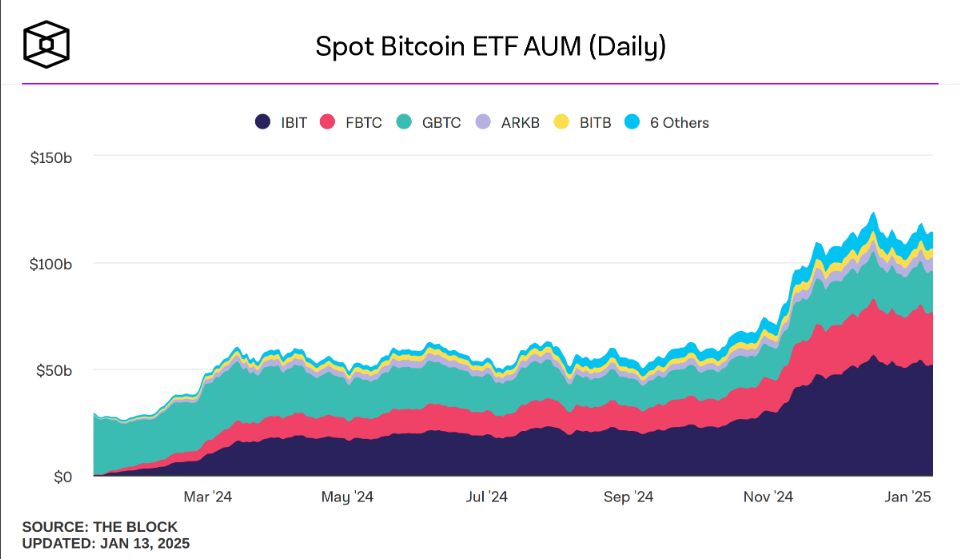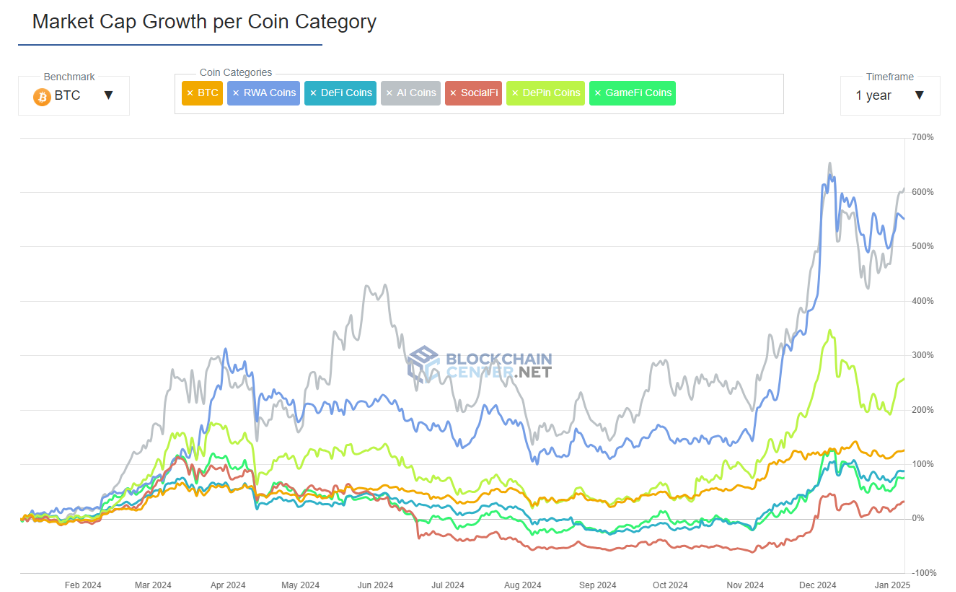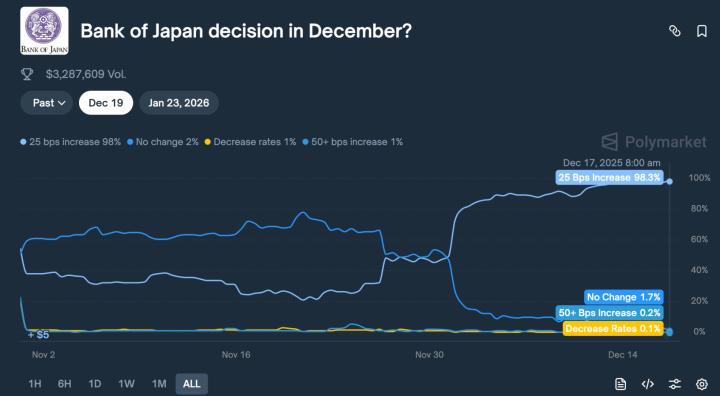3 Reasons Why 2025 is Destined to Be Another Pivotal Year for Bitcoin and the Crypto Industry
With increased political support for cryptocurrencies and advancements in Blockchain and AI, 2025 is set to be an unforgettable year for the crypto industry.
2024 was the year when Cryptocurrencies became an influential force in the global tech and financial landscape, no longer just a niche in the financial world. Unprecedented political support, the rise of AI, RWA (Real-World Assets), and fierce Blockchain competition defined the past year and laid the groundwork for the anticipated 2025 bull market for most investors.
In a world ravaged by inflation, Bit prices soared after the Bit halving in April 2024. Notably, this surge was driven not only by retail investors and Michael Saylor but also supported by some of Wall Street's biggest heavyweight investors who gained exposure through spot Bit ETFs. This momentum even reached Washington D.C., with President-elect Donald Trump and many legislators publicly declaring their support for cryptocurrencies.
Meanwhile, smart contract platforms vied for dominance, with Ethereum performing averagely, reflecting the rise of its competitors. In the Web3 space, new trends became the focus, with tokens related to AI and RWA being the year's biggest winners.
Bit Aims for New Price Highs
In 2024, Bit repeated its standard post-halving pattern, rising 126% on the back of traditional finance and political recognition.
The newly launched spot Bit ETFs, by attracting investors and companies to inject new capital, transformed the Bit market, making it easier for them to access Bit.
In January 2024, nine asset management firms, including the world's largest asset manager BlackRock, launched their first spot Bit ETFs. By the end of the year, their total Assets Under Management (AUM) soared from $27 billion (from the existing Grayscale fund conversion) to $109 billion.

The potential for strategic Bit reserves to be established could also provide a boost to Bit prices in 2025. Long-time Bit supporter U.S. Senator Cynthia Lummis has proposed the Bit Bill, which, if legislatively approved, would compel the U.S. to purchase an additional 1 million Bits "as an additional store of value to strengthen the U.S. balance sheet."
Whether this bold idea will gain Congressional support remains to be seen. However, the November elections have improved its chances of success. According to OpenSecrets, in the 2024 election cycle, Fairshake PAC-backed campaign spending totaled $172 million, with many pro-crypto candidates winning, even replacing incumbents opposed to cryptocurrencies. StandWithCrypto data shows 247 pro-crypto candidates were elected to the House, and 15 to the Senate. Considering only 33 Senate seats were up for election in 2024, this is an impressive outcome.
Intensified Competition Among Smart Contract Platforms
While investors typically focus on Bit's role as a currency, most other Blockchains serve as smart contract platforms, supporting the development of decentralized applications (DApps). In 2024, these Blockchains made progress in quietly upgrading their technology. Specifically, Solana released its Firedancer client to improve scalability, while Ethereum underwent the Dencun upgrade to reduce transaction fees in its Layer 2 solutions.
Market competition is intensifying, and Blockchains must continually evolve to attract users and developers. The past year has shown that even Ethereum, with its many Layer 2 solutions, may risk losing its competitive edge as faster and cheaper Layer 1 Blockchains like Solana gradually catch up.
From a financial perspective, this uncertainty led to Ethereum's price increasing only 65%, and muted interest in spot Ethereum ETFs. In 2025, the Ethereum network will see the Pectra upgrade, allowing Externally Owned Accounts (EOAs) to directly execute smart contract code. This will bring Ethereum closer to full account abstraction, enhancing account flexibility and user experience. However, ultimately, the value of Ethereum - and any Blockchain - will depend on the industry's ability to deliver useful real-world applications.
AI and Real-World Assets (RWA) Drive Web3 Growth
The main promise of Web3 - a decentralized internet - has yet to be realized. However, 2024 saw some progress towards this goal.
The biggest Web3 trend in 2024, unsurprisingly, was the advancement of Artificial Intelligence (AI). Top projects include Render Protocol (RENDER +125%), the machine learning network Bittensor (TAO +135%), and the AI agent protocol Virtuals, which saw astronomical growth (VIRTUAL +33,000%). Overall, AI tokens surged 630% in 2024, according to BlockchainCenter data.
Following closely are Real-World Assets (RWA) protocols, which cover those relying on tokenizing real-world assets like securities, debt, real estate, and art. Structured finance product platform Ondo Finance (ONDO +705%) and lending DeFi protocol Mantra (OM +6,866%) are leaders in this space. Notably, stablecoin giant Tether joined this trend in November 2024 by launching its asset tokenization platform Hadron.

Maturing Web3 domains are also gradually gaining attention.
Decentralized Physical Infrastructure (DePIN) tokens are one of the leading Web3 domains, with a 270% annual growth rate. Their main promise is to allow users, device owners, and enterprises to collectively own and monetize digital infrastructure. Filecoin and the streaming-focused platform Theta are prominent DePIN representatives, while AI-utilizing protocols like Render and Bittensor also fall under this category.
Decentralized Finance (DeFi) also saw an upward trend in 2024. According to DefiLlama, the Total Value Locked (TVL) in DeFi reached an all-time high of nearly $250 billion by December 2024. The most notable launch in 2024 was EigenLayer, a re-staking protocol that quickly became the third-largest globally, with over $17 billion in TVL.
Crypto gaming also continued to evolve, with the number of unique active wallets reaching nearly 9 million by the end of 2024, a significant increase from 1.3 million in 2023, according to DappRadar. High-profile 2024 launches like 'The World of Dypians' and 'Seraph', as well as the popular Telegram game 'Hamster Kombat', drove this growth.
Looking ahead, the momentum gained in 2024 appears poised to continue into 2025, primarily driven by the pro-crypto Trump administration, the sustained Bit bull market, and ongoing advancements in Blockchain technology.








